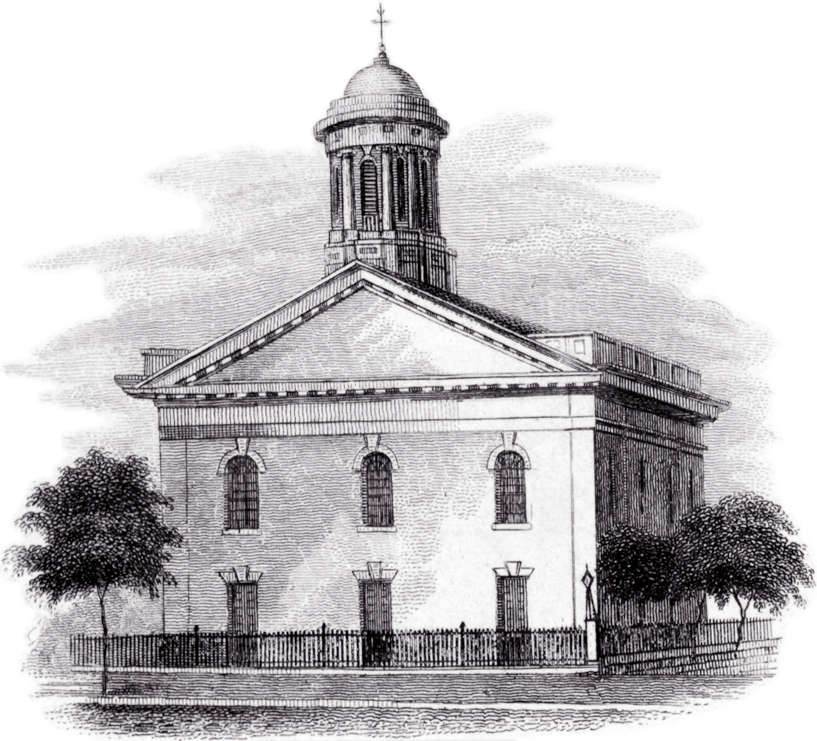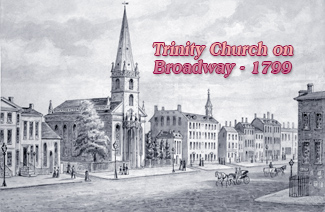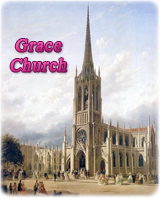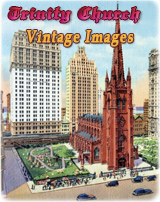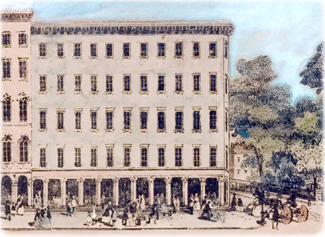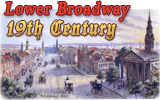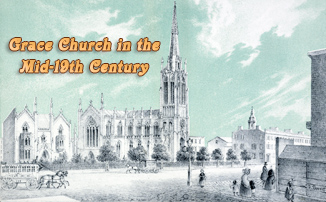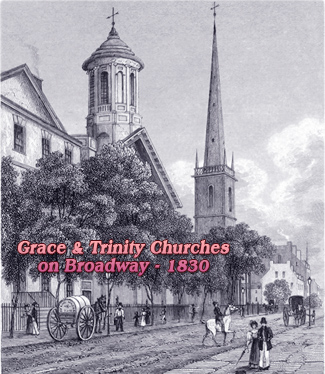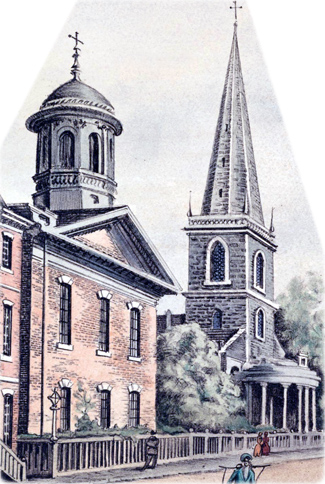On
February 9, 1804, the Trinity vestry "resolved that Mr. Watts, Mr. LeRoy and Mr.
Bayard be a Committee to purchase a proper situation for building a new Church”,
later called Grace Church. On February 18, the committee reported that a
Committee from the Lutheran congregation had made them an offer of their
property in Broadway, upon a perpetual lease, the consideration of which report
was postponed. On May 10, the committee was authorized to treat with the
trustees of the Lutheran Congregation for their lot in Broadway. On June 14, the
committee reported that they had conferred with the trustees of the Lutheran
Congregation who are disposed to sell the reversion in fee of their lot in
Broadway, the vestry to be at the expense of buying the lease of the hotel,
seven years of which are unexpired. On June 22, Trinity vestry authorized the
committee to buy the lot on Broadway belonging to the Lutherans, together with
the lease of the hotel.
On January 24, 1805, the Trinity vestry "Resolved that the Clerk of this Board [Trinity vestry] inform Messrs Mathew Clarkson, Herman LeRoy, Peter Schermerhorn, Henry Rogers and Gulian Ludlow that they have been nominated as proper Persons to be Trustees for a new [Grace] Church, until the same can be incorporated according to Law, and request to know whether they will act as such". On February 14, the Trinity vestry directed the trustees to present plans and estimates for a church to be built “on the Ground lately purchased for that Purpose in the Broadway". Trinity bought the land from the Lutheran congregation for £6000, according to the Journal of the Lutheran Church, dated May 1805. The old Lutheran temple was demolished soon after to make way for Grace Church.
On April 11, Trinity vestry appointed a committee to obtain proper estimates of the expense that would attend the building a church upon the plan furnished by Mr. West. On June 1, the Trinity vestry passed a resolution that “the Lease of the Lot of Ground, in the Rear of the Land lately belonging to the Lutherans, be bought . . . and conveyed in Fee to the Trustees to whom the said adjoining Land has been conveyed" (a parsonage-house existed in the rear of Grace Church in 1833).
On March 18, 1806, the cornerstone of the Grace Church was laid at the southwest corner of Broadway and Rector Street. The temple was consecrated on December 21, 1808, when the first worship service was held in the church. Grace Church was established as a separate church.
This temple was built of brick, 101 feet long by 57 feet wide, with a neat cupola with columns of the Ionic order. The rear of the temple was of an elliptical form, with a terraced garden and the Rector's house adjoining. The interior had four massy Ionic pillars supporting an arched ceiling. The pulpit was in front of the ellipsis, with a railed mahogany enclosure surrounding the altar with stone stairs.
In the gallery, fronting the pulpit, there was a large organ made by Geib. In 1830, large new organ was erected, which contained upwards of 1500 pipes, and had three sets of keys, pedals, coupling movements, combination pedals and other improvements. These instruments were from the manufactory of Mr. Henry Erben of New York City.
Thomas Pope, in A Treatise on Bridge Architecture, published in 1811, mentioned several buildings in New York, noting that "there are some excellencies in the new Grecian structure called Grace Church".
A charity school for girls and another for boys were opened in 1823.
In December 1834, a mural monument was erected in Grace Church, in memory of Cadwallader D. Colden, grandson of the colonial governor and former mayor of the City, who died on January 7. The inscription was written by Gulian C. Verplanck (1786-1870), former member of the New York State Assembly, later member of the New York State Senate.
In the late 1830s the city was moving northward and Church attendance was declining. Rector Thomas House Taylor convinced the congregation that the move was vital to the Church’s continued growth and vitality. By May 1843, the society of Grace Church decided to built a larger temple farther north. The site was chosen and property was purchased. The new temple of Grace Church was consecrated on March 7, 1846. However, the Evening Post (December 11, 1848) reported that "The new Grace Church is opened for the first time" (December 10).
The original temple was sold by June 1845. Doctor Taylor, the rector, preached the last sermon in the old edifice on Sunday, June 15, that year. The congregation occupied a temporary place of worship until their new church at the upper end of Broadway was ready. The new owners had the intention to convert it into stores below, and the upper part into a museum of Chinese curiosities, but it seems like the venture didn't work out. On August 21, 1847, the Evening Post reported that "The crumbling walls of old Grace church which have so long disgraced the lower part of Broadway, have at length been demolished". The same newspaper reported on September 22, 1848 that "The Ruins of the old Grace Church, at the corner of Broadway and Rector street, so long an eyesore to good taste, are about to disappear before the spirit of improvement. The lot and ruins in question have been purchased of its late owner, Elihu Townsend, Esq, by John Jay Phelps, of the firm of Phelps, Chittenden & Bliss, with a view of erecting there a magnificent building for stores and offices, which shall amply develope the great advantages of its site. It will extend 78 feet on Broadway, and 223 feet on Rector street (...). The building will be five stories high [see image on the right], constructed in the most substantial and durable manner, with a front facing of free stone. In point of finish and elegance it will rival the large and beautiful free stone stores recently erected by Mr. Phelps in Courtlandt street."
In the early 1850s, a commercial building occupied the site on Broadway at Rector Street. The Empire Building, completed in 1898, occupies the site today.
In 1903, the original corner-stone of the first Grace Church, secured from the N. Y. Historical Society, was placed within the inner wall of the present church temple, near the entrance.
